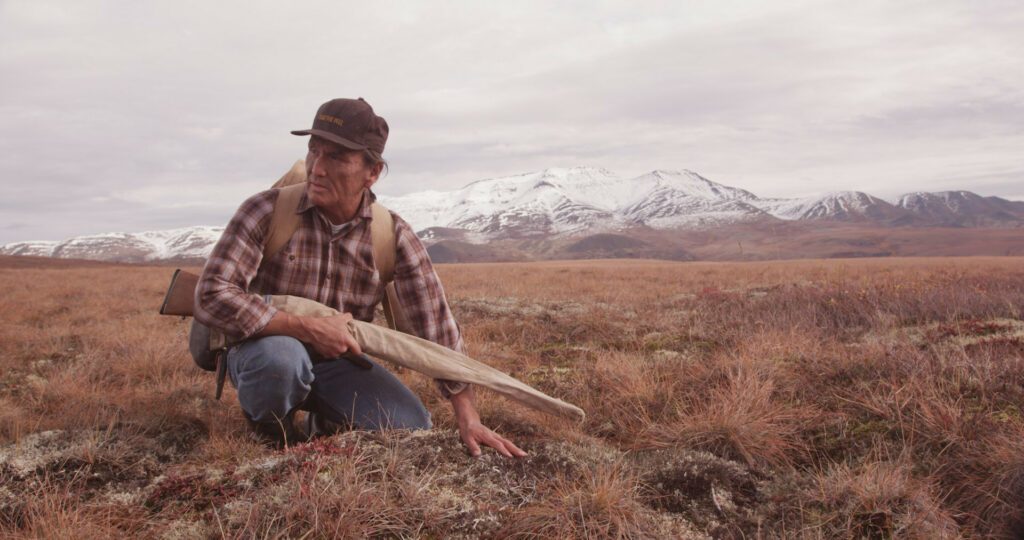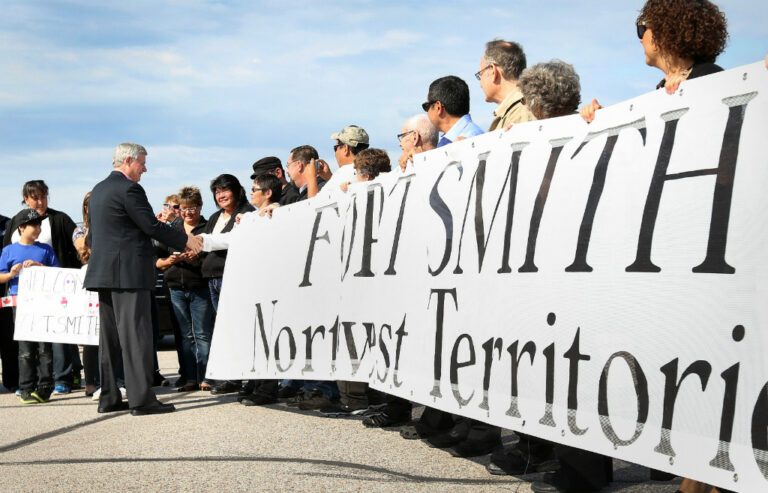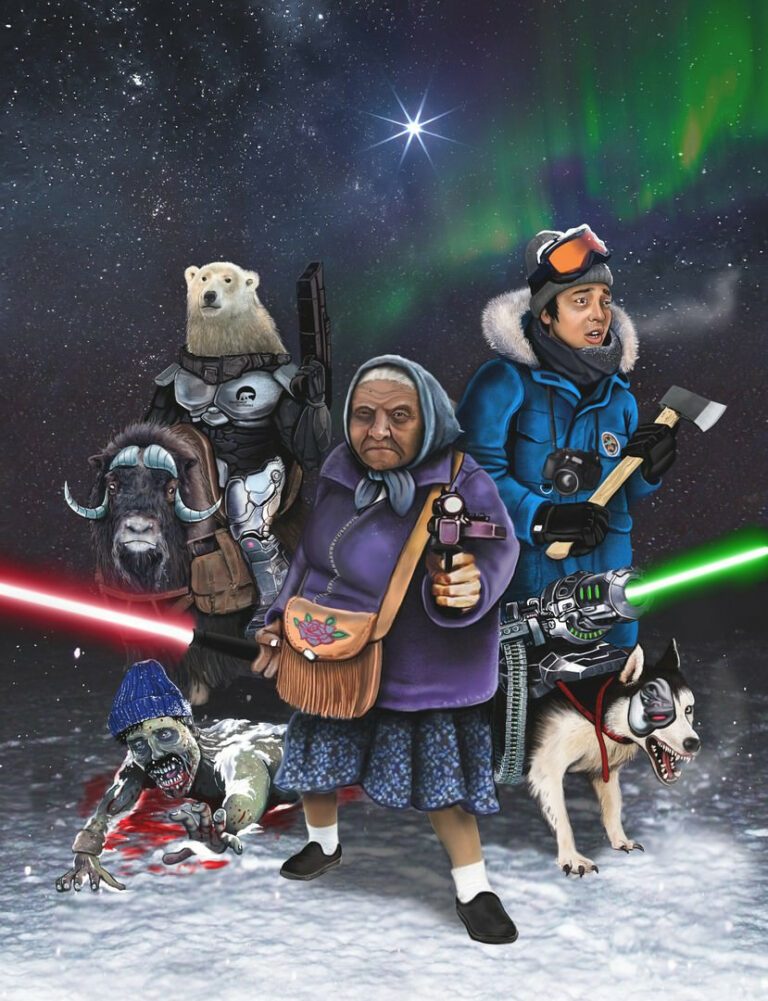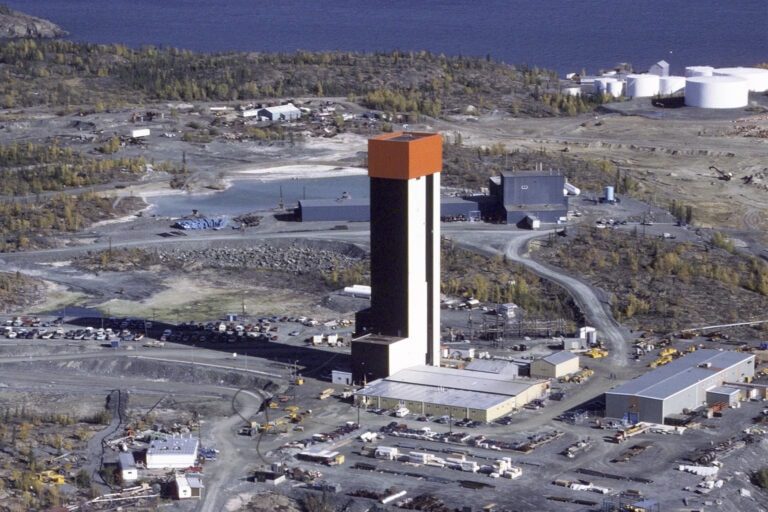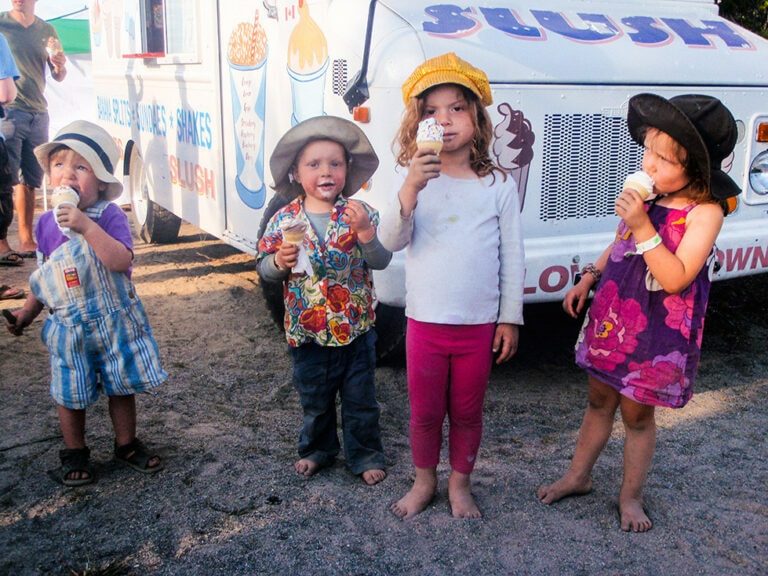From navigating foggy grizzly country with guns to fighting off hypothermia, the shoot behind The Sun at Midnight will likely go down as one of the toughest productions any of the cast and crew has ever faced.
“It was the least Hollywood production you can imagine,” recalls Jay Bulckaert, who served as first assistant director on the shoot, which took place last fall around Fort McPherson.
Shot entirely in the North with a primarily northern crew, The Sun at Midnight might be the most NWT feature film ever made. The original story, by NWT filmmakers Kirsten Carthew and Amos Scott, follows a young woman who returns to her Gwich’in homeland from the city to befriend a hunter obsessed with tracking the missing caribou.
“What we did in Fort McPherson was we went into battle every day. It was tough, it was cold, it was muddy and it was exhausting.”
The film premieres this weekend in Fort McPherson before screening at the Yellowknife International Film Festival next week. Starring rising star Devery Jacobs of Rhymes for Young Ghouls and Duane Howard of The Revenant along with a handful of local, first-time actors from Fort McPherson, the film is also expected to generate some buzz when it hits the ImagineNATIVE film festival in Vancouver next month.
But looking back to a year ago filming out on the tundra, Bulckaert says the success of the production — one with a very minimal budget and shot in a very remote area — was always up in the air.
“What we did in Fort McPherson was we went into battle every day. It was tough, it was cold, it was muddy and it was exhausting,” he says. “I’m so proud of what we pulled off, and of Kirsten for pulling through; she’s worked on that film for a decade of her life. But there were definitely moments when it was like, ‘I don’t know if we can pull this shit off.’ It was definitely debatable as to whether or not we could pull off a feature film here in the North with a crew that was primarily Northern.”
The landscape and season had been selected to highlight the brilliant colours of the area in autumn, but the fall also brought cold, rain, fog and a never-ending mess of mud. Some of the pre-scouted locations were snowed-in already and Carthew says the schedule turned into “trial by fire filmmaking.”
“It was not the most ideal,” she says. “Low budget, outdoor filming, being at the whim of whatever nature was trying to do, and trying to do it all in a short period of time — we had all of these challenges, and I think one of the coolest things about the film was that we made it. It was a very challenging shoot.”

Some of Sun‘s cast and crew: Veronica Spears, makeup; Kirsten Carthew, director; and Devery Jacobs and Duane Howard, the two leads | Photo via Playlist
A major obstacle for the production was the rain, which turned the community, the roads and the general landscape into a slippery mess that made driving perilous and coated everything from clothes to camera gear in mud.
“It kind of felt like a prison camp, having the boss walk around with a gun.”
“We ended up jokingly calling it ‘The Fog at Mud-night,’” Bulckaert says. “There was mud everywhere. It was tough. There were lots of fun times on set, but I’m not going to downplay the slog that it was to actually pull this off. It’s quite amazing to me that we did.”
Shooting in the mountains off the unpaved Dempster Highway meant the temperatures were cold and wet, so much so that Howard nearly got hypothermia after a long take on the damp moss near an alpine creek.
“That was the most stressful day for me,” Scott remembers. “It was the middle of the shoot. You’re at the point where you can’t turn around and go back. We were so close to being done. But it also ended up being really fun, because if you look back at the footage, the cold and the fog worked so well for the characters and the movie. We needed that kind of weather to make the movie a little bit more dramatic.”
Then there were bears. As producer, Scott had the responsibility of keeping all the cast and crew safe during the filming, meaning he spent a lot of time on grizzly patrol, trying to sense out any dangers lying beyond the fog and piles of fresh bear scat.
“I was always on guard, but it made it kind of funny — the producer of a show being the one walking around set with a rifle,” Scott says with a laugh. “It kind of felt like a prison camp, having the boss walk around with a gun.”
The shoot literally took place off the side of the highway, devoid of any luxuries. Cast and crew spent, on average, 12 to 16-hour days out in the elements, pushing through the scenes as weather permitted. Hair and makeup were done in the cabs of trucks and people went to the bathroom wherever they could find a discreet location.
While the shoot was a bit of an adventure for the crew from Vancouver, having a majority northern team meant the rough, bush style of filmmaking was just accepted as a fact of life.
“[Having a] minimal crew, where everyone has to do everything — that’s our every day in the film industry here in the North,” Bulckaert says. “Shooting in the bush and having to have a live gun on set for bear patrol, everyone being freezing cold — that’s normal life for us. That’s all we do.”
The film was somewhat of a test run — not just for the crew as their first feature film, but for the film’s funders, the NWT Film Commission and Telefilm, along with associate producers the Gwich’in Tribal Council’s department of Cultural Heritage, in investing in Northern cinema.
“One of the great experiences at the end of the filming was, even though it was hard, we did it and we can do it again,” Carthew says. “We learned and we can pay our knowledge forward and go on to create more projects here.”
While Carthew hopes the film garners a global audience in order to showcase the beauty of the Northwest Territories, she says the film is primarily a gift to the North.
“It’s inspiring to see people and places you know on the screen,” she says. “There’s nostalgia and pride in that, and it’s something we can give back to the North because the North helped to make the film.”
The Sun at Midnight’s first screening at the Yellowknife International Film Festival, at 7 p.m. on October 1 at the Capitol Theatre, has sold out. A second screening, at 2 p.m. on October 2nd, has just been added.

